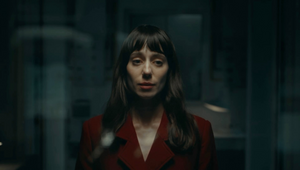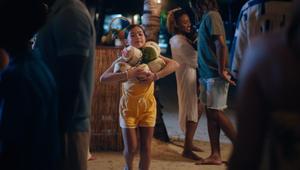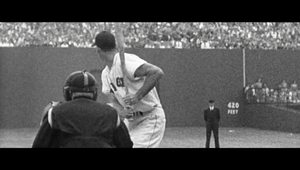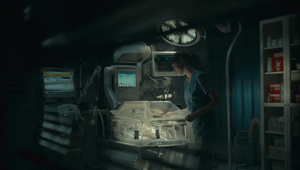
The Nerve-Wracking Story Behind the Most Daring Gun Safety Campaign Ever

This year, as high school students around the United States of America get ready to graduate and celebrate moving onto a new stage in their life, 3,044 students won’t be joining in. There is a ‘lost class’ of 3,044 students, dead due to gun violence.
Change the Ref is a gun safety organisation founded by Manuel and Patricia Oliver, in honour of their son, Joaquin who was murdered at the Parkland school shooting in Florida in 2018. They’ve been working to change gun laws since, and they were keen to focus on graduation as a time to focus attention.
Advertising agency Leo Burnett came up with the idea to get David Keene, former president and current board member of the NRA, and John Lott, American economist, political commentator, and gun rights advocate to deliver commencement speeches to 3,044 empty chairs, representing the dead students who were due to graduate this year.
It was no mean feat. It’s a stately, sombre affair filmed against the dramatic backdrop of a scorching Las Vegas (itself the site of mass shooting in 2017). Director Bryan Buckley of Hungry Man created a dramatic film that shows the empty seats in a way that makes them look like graves. In terms of the practicalities of pulling off such a stunt, they brought producer Jordan Cohen on board, who was able to draw from his experience on Borat: Subsequent Movie Film.
Since the video was released on Thursday, it has been picked up by media around the world.
LBB’s Laura Swinton caught up with director Bryan and Leo Burnett EVP/ECD Sam Shepherd, EVP/ECD, and EP Ashley Geisheker to get the lowdown on this emotional, nerve-wracking production.
LBB> What was the conversation with Change the Ref that sparked off this project? And how did you zero in on the idea of an empty graduation?
Sam> When talking to our clients, Manuel and Patricia, the one thing that really hit me was how their son, Juaquin, was just days away from graduating high school before he was murdered. That conversation was a gut punch, I had to go off Zoom for a moment to ground myself. It felt like a specific area we could focus on to get people’s attention. When the teams found a picture of an empty graduation, the single image alone was so powerful, we knew we had a starting point.
LBB> This is the sort of thing you really want to get the tone right on - with the wrong approach, it could easily be flippant in execution, which it definitely isn't. How did you figure out what that tone was?
Sam> Keeping the focus on the 3,044 students that didn’t get to graduate this year dictated our tone. It kept the tone tasteful. It’s not about tricking people. Yes, getting the NRA speakers to finally confront the facts was a major component for shock value and getting this message on a world-stage, but we never wanted to lose sight of the reason why we all dropped everything for this project. Kids are dying, senselessly, because we have failed to pass basic gun control legislation.
LBB> Pulling such a daring stunt is inevitably going to be a bit risky - did you have any worries ahead of hitting 'go' on it? What sort of conversations were had and what convinced you all to go ahead with it?
Sam> Every single person, unanimously, at the same time said, “let’s go for it.” It’s rare you have that many partners, all holding hands, ready to take on an enormous risk. That fearlessness started with Manuel and Patricia pushing our creative team to think bigger. It’s not every day you have your client say “you were put on this earth to do this project.” It extended to our director, Bryan Buckley, who brought a whole new dynamic of ambition and drive. And then internally, having the trust from Leo Burnett to go all the way was everything. I don’t know if I’ll ever see another project come together with such relentless courage like this again.
Ashley> Any reservations were overshadowed by the bigger picture of what we were aiming to accomplish – and that was honouring Joaquin, all the other victims of gun violence and bringing attention to changing the legislation around universal background checks. The moments of self-doubt or nervousness were fleeting – the message is too important to not go all in. Every production partner we engaged with felt as passionate about the cause as we did.
LBB> Bryan, what was your reaction when you first saw the idea? And why was this a cause you were really keen to get involved in?
Bryan> Gun violence is out of control in this country. Anyone who's willing to fight the battle for gun reform I will listen to. This piece came in and it simply blew me away. The idea of lost class was just so crystal clear. 3,044 high school kids who never got to live the lives they should because of a bullet. It was genius.
LBB> How did you all work together to develop the idea and the look of the film and graduation? You could have gone quite guerilla and 'shakey' but instead went for a very cinematic, sombre, almost meditative approach to the direction - why was the direction you wanted to go in?
Sam> We had an enormous amount of trust in Bryan. At the beginning, we weren’t just looking for any director to help us on this project. We knew we had to have a creative partner that was as emotionally invested in this cause as we were. That’s Bryan Buckley. This wasn’t just another job for him. He was there with us, brainstorming every step of the way. The cinematic quality of our films is a result of Bryan never wanting to do anything half-assed. It wasn’t enough to just capture this event with hand-held, shakey footage. We had to go all the way, and make it as powerful as possible.
Ashley> Bryan was one of the first directors I thought of when we were developing the project. We knew the idea was bigger than just a simple film. The work he did on the Trump Statue Initiative came to mind, because I knew he would embrace the cause and bring so much more to the idea. The cinematic approach was so purposeful - revealing the chairs that were art directed in a way that was reminiscent of tombstones was striking.
Bryan> Visually and conceptually the idea was insane. What I thought it was lacking was something that made it transcend it just being a powerful ad. There have been endless powerful ads done on guns. But here we are daily reading mass shooting after another mass shooting, so I pitched Sam the idea of having a member of the NRA doing the commencement speech to these empty chairs. After all, they've been making these 2nd amendment speeches for years. And raising funds with them. Why not show the world the result of their words? We could create a fake high school online, recruit these guys, and tell these NRA guys we were doing a rehearsal which we would shoot. It would be an event. And yeah, we would have it in Vegas because no one knows what the hell is going on in Vegas, and what NRA guy isn't going to want to go there? Sam smiled - and said this sounds really good.
As far as the look – I wanted it to be cinematic - 2:40. The chairs begged for that. The event begged for that. We shot five cameras and, knowing we only had one shot, Scott Henriksen my cinematographer and my production designer David Skinner did some pre-viz work so we would know exactly where to be with the cameras. And we found some amazing shots in there. One of which was the drone shot on a pullback.

LBB> Visually, I was struck how the white chairs in rows against the neat green grass really resembled those vast WW1 war cemeteries in France and Belgium. I found it totally chilling. Was that intentional?
Bryan> Absolutely intentional. Lined up like graves. No rows in-between. What none of us knew was what 3044 chairs would actually look like once you put them out. And it was more powerful and haunting than I could ever have imagined. We ended up going off the tarp as there were so many chairs, and the number kept growing during production.
LBB> That grand pull-back drone shot is such a reveal and really overwhelms the viewer as you see more and more empty chairs - what were the challenges involved in getting this shot?
Sam> In all honesty, the heat was the biggest challenge. It was 110 degrees [Fahrenheit] in Vegas while we were shooting, so it was hard to coordinate a seamless drone shot under pressure. We only had one chance to get it right while our speakers were giving their address.
Ashley> In addition to the heat - the security on set was also paramount. There purposefully was only a small amount of crew that was present while filming. Having to be that incredibly nimble was a feat.
Bryan> We rehearsed the drone before our speakers got there. Knowing it was basically a one-shot deal, we saved it til the end of our shoot because you never know what can happen with a drone. Wind (which there was plenty of), temperatures, draining batteries. We let the main speeches finish. So we asked Keen and Lott to do one more pass for the drone at the beginning and the end of their speeches.
LBB> How on earth did you convince David Keene to take part? And on the day how did you convince him to read the speech out to the crowd? Were there any moments you thought you'd been rumbled?
Ashley> Pulling this off wouldn’t have been possible without all our production partners. Bryan and the Hungry Man team assembled an amazing all-star team. Unicorns & Unicorns supported us with all the web development and brought many clever ideas to the table. There were so many moving parts and layers of details that went into the project in order for it to be successful. It really was a situation of some of the most clever and agile minds coming together to orchestrate it all.
Bryan> Well, first we got Jordan Cohen onboard as a producer. He is an expert in this area and has worked on some pretty high-profile films such as Borat that involve this sort of thing. He would head up recruitment and brought a troop of improv actors to become the president, event coordinator, and assistant. We zeroed in on targets. Meanwhile the agency created the James Madison academy site. The name was so good - every detail thought out. All the way down to giving the two speakers fake awards: "The keeper of the Constitution awards".
Far as how we got them to speak in front of empty seats… I had done a convocation speech a few years ago at Syracuse University. I remembered I had to do a rehearsal before empty seats, so it made total sense. We told them we would shoot the rehearsal to make sure we got the best of their speeches because the next day before a huge crowd of 3000 kids it was gonna be nuts.
LBB> Were there any moments you thought you'd been rumbled?
Bryan> There were plenty. The biggest thing was getting them to sign a release to let us use whatever they said on camera, and when they signed it… we all looked at each other and knew this was close to happening.
LBB> What were your memories of the shoot - what was the atmosphere like on set?
Sam> Hot. Shooting non-stop in Vegas during 110-degree heat in the middle of the day was brutal. But everyone involved on set was laser focused on getting this done. It was incredibly intense, because at any moment we knew the whole project could be stopped. Either by the speakers, or by someone else that asked too many questions. There were only a handful of us that knew the whole scope of what was going on.
Ashley> This particular time on set was like nothing I had ever experienced. Sitting in our video village in an unassuming RV, being able to watch everything happen alongside Manuel and Patricia was incredibly moving. I experienced every range of emotion on the day, and am still in awe of what the team accomplished. Listening to those speeches in real time is a moment I’ll never forget.
LBB> When it came to the edit and sound design, cutting the speech with the voicemail messages of murdered students is just so powerful - at what point in development did you come up with this idea and how did you work with the editor and sound designer to really make it work?
Sam> Our editor, Jason MacDonald, came up with the idea for the 911 call audio in the second half of the film. He knew it wasn’t enough to portray what happened on the day of the shoot, we had to give each piece another layer of emotion and connect it all back to the reality of gun violence in America. That decision was a great metaphor for this entire project. It wasn’t enough to just shoot the 3044 empty chairs. We had to go all the way.
Bryan> Jason Macdonald cut the speech first, then came the titles, then came we knew we needed something to bring life to the chairs. To let us know there was a special life lost who was supposed to be sitting in that chair. Was it a visual of a kid? Was it sounds? The 911 calls just made a whole lot of sense. They were powerful and real, and allowed Keene's speech to go on against it.
LBB> Emotionally, listening to those messages and pouring over them in the edit must have been really difficult. How did you process that?
Sam> This was the most difficult project many of us have ever worked on. Listening to the sounds of that 911 call was really hard. But I think what helped was knowing no matter what, this piece had to drive maximum impact for whoever saw it. Not just anyone who cares about gun violence. Because the problem is bigger than that now. Everyone needs to see this project, and do something about it.
Bryan> It was hard. Jason had done Sandy Hook and March for our Lives. Sadly, he was all too familiar with the library of 911 shooter calls that keep growing and growing.
Ashley> The first time Jason played the 911 call on our remote edit session, I went off camera and had to compose myself. It all just hit me at once. The chairs. The speakers. The video village with Manuel and Patricia. Then when you see all those elements put together in the edit, it reinforces the message that much more.
LBB> The film is incredibly powerful - what was the strategy around making sure this event was amplified?
Sam> Our main strategy was keeping everything a secret as long as possible. Which was incredibly challenging. We worked around the clock to finesse and perfect every asset until we were ready to go live.
Ashley> In terms of getting this messaging out into the world, it was critical to take a non-traditional approach and leverage relationships within different political networks. Our goal was to make sure this was seeded in a way that launched a platform for Manuel to speak out about universal background checks.















